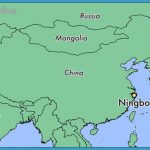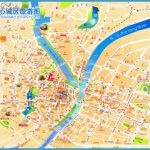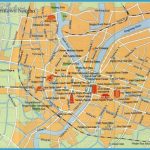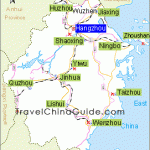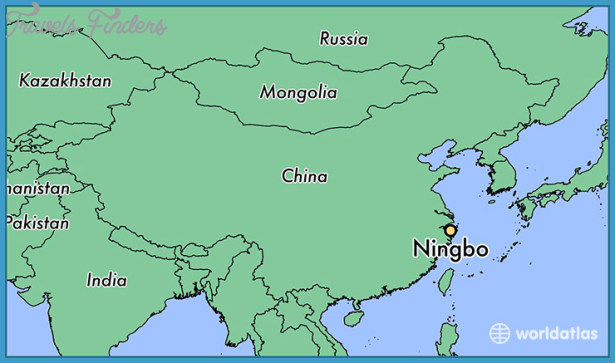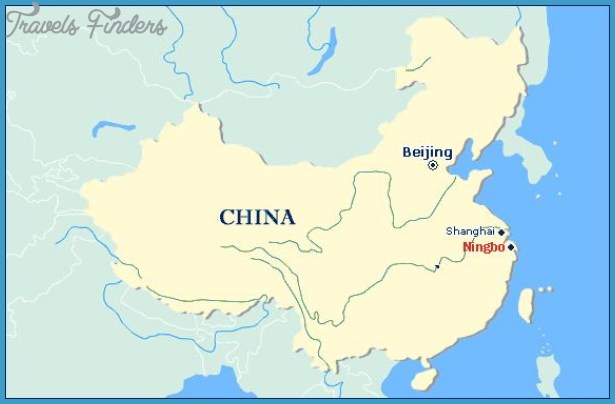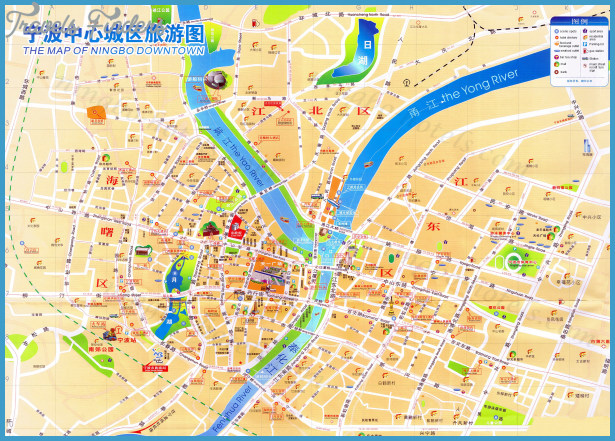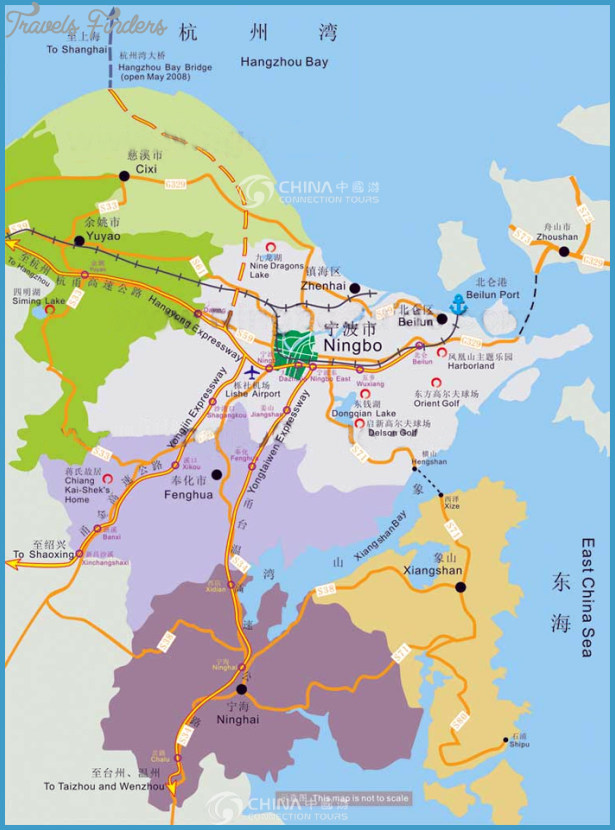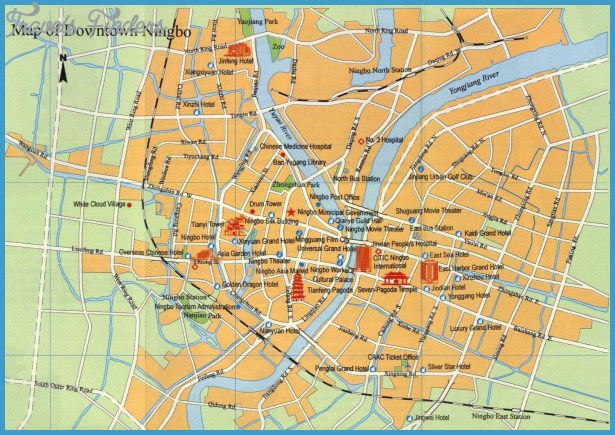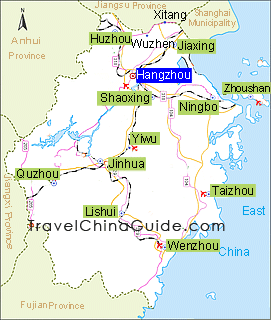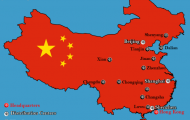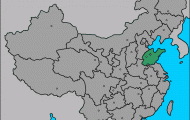Province: Zhejiang. Area: 1033sq.km/399sq. miles Population: 1,040,000 (conurbation 4,980,000)
Ningbo is situated at 121°32’E and 29°51 ‘N, in the north-east ofthe province of Zhejiang, 25km from the East China Sea, at the confluence of the Yao-jiang and Yongjiang Rivers.
This important port with its network of navigable canals is also a busy industrial and trading centre and has been dubbed “Little Shanghai”.
The city has connections by bus, train, plane and ship with both the provincial capital, Hangzhou, and Shanghai.
As long ago as the Qin period, about 2300 years ago, the city was of considerable importance. Under the Tang dynasty (618-907) it grew to be one of the most important ports in China. When the Song dynasty moved its seat of government to Hangzhou in 1127, Ningbo’s prosperity grew in leaps and bounds. By the 16th c. foreign ships were also calling at the port and the local merchants were gradually able to extend their commercial connections to Japan, Korea, south-east Asia, Europe and even America. The first modern factories were established around the middle of the 19th c. and about this time the port was forced to open itself up to foreign powers. As a consequence of being awarded the status of “coastal port open for foreign trade”, Ningbo has been able, in the last few years, to make considerable progress in the industrial and service sectors.
The Unique Pavilion under the Sky, in the west of the city, was built by the high-ranking official Fan Qing between 1561 and 1566 in orderto house his private library, which is one of the’oldest of its kind in China. In front ofthe two-storey wooden building an artificial pond was laid, which was intended to provide water in the event of a fire. Originally the library collection consisted of 70,000 volumes, but over the centuries the stock has been decimated by theft. Today, however, the library has recovered its former glory and at present can boast a collection of over 80,000 books, incunabula, old manuscripts and a large number of inscriptions in stone dating from the 14th 19th c.
The seven-storey Tianfeng Ta Pagoda (approx, 55m/180ft high) is situated in the south of Ningbo and dates back to 695, in other words the Tang era-hence its popular nomenclature of Tang Ta (Tang pagoda). Fire and lightning have damaged and even destroyed the hexagonal building on several occasions. The building’s present appearance goes back to the year 1330, while its last restoration occurred in 1957.
It is well worth climbing up to the top storey of the pagoda in order to enjoy the superb panorama ofthe city.
Baoguo Si Temple, 15km/9 miles north of Ningbo, comprises a number of buildings.
The main hall of the temple, the Treasure Hall of the Great Hero, is consecrated to Buddha and is the oldest wooden building in the province, dating back to 1013. The temple’s much venerated sculpture of Buddha dates back to 1102, as the inscription on the base ofthe statue testifies,
35km/22 miles east of Ningbo, at the foot of Taibaishan, stands Tiantong Si Monastery, which was built in 300 and has been rebuilt and extended many times. The present buildings date from the Qing era (1644-1911). The monastery exerted a great influence on the course of Japanese Buddhism. In the 13th c.the monkDogen came to study here. He founded the Sotoshu sect, a branch of the Buddhist religion which is still important today in Japan. Its adherents still continue to visit the monastery.
In the main hall three sculptures can be seen which depict Buddha in the past, present and future. The two small statues in front are of Ananda and Mahakasyaoa, two of the ten favourite disciples of Buddha. Nearby there are another 18 portraits of Arhat.
The Ashoka Monastery was founded in 425, not far from Tiantong Si, and achieved fame through a stupa which is said to contain a bone belonging to Shakyamuni. According to tradition it was found by Liu Sake in 282. The bone is today kept in a wooden dagoba inside the stone stupa, for the protection of which a temple was specially erected. Behind the stupa can be seen a statue which represents Shakyamuni entering Nirvana, while on the back wall of the temple four guardians of heaven are depicted in high relief. On the terrace in front ofthe building a number of stelae are displayed, the oldest of which dates from 833. The 36m/118ft high tiled pagoda to the west of the temple was built in 1365.
In the village of Hemedu, about 50km/30 miles north-west of Ningbo, the remains of an ancient civilisation were discovered in 1973, The first and second of the four excavation layers have been assigned to the Neolithic period. Among the finds should be mentioned terracotta objects, tools made of wood and bone, grains of rice, bones of breeding pigs and buffaloes. These all confirm the advanced state of development attained by these people, who must have settled in this area six to seven thousand years ago.
Putuoshan rises up some 100km/60 miles east of Ningbo (accessible from there by ship) on an island just 12sq.km/4y2sq. miles in area, which belongs to the Zhoushanquando group of islands. Together with Wuteishan, Emeishan and Jiuhuashan it belongs to the Holy Mountains of Buddhism. Many legends have grown up around the mountain and island: in 916 a Japanese monk tried to bring a statue ofthe Goddess of Mercy (Guanyin) to his country, but when he came to this region, an iron lotus flower rose up from the water and barred his way to his ship. Thereupon the monk took a vow to build a temple, at which the lotus flower vanished. A short time later the “Temple of Guanyin, who does not wish to depart” (Bukengqu Guanyi-nyuan) was built on the slope of the mountain. According to another legend, after a long period of meditation, the Goddess of Mercy is supposed to have received enlightenment on nearby Luojiashan. She then crossed the sea with a single leap and cameto rest on Putuoshan where she left behind a footprint. Between the 10th and early 12th c. 218 monasteries, accommodating some 3000 monks, were built on the mountain.
Among all these religious buildings the Monastery of Universal Salvation stands out. Built in 1080 it covers an area of 14,000sq.m/3!/2 acres and comprises seven temples, 12 pavilions and 16 other buildings. The Yuantong Baodian Hall, the largest of all the temple buildings, will accommodate 1000 people. The second largest monastery is Fayu Si. In the Yangzhi convent the stone likeness of Guanyin is of particular interest. The prince’s stupa (Duota) dates from the 14th c.
Tiantaishan, about 100km/60 miles south of Ningbo, lays claim to being the birthplace of the Buddhistic Tiantai School.
On the slopes of Tiantaishan there are a number of Buddhist monuments to be found. The most famous is Guoqing Si Monastery, dating from the year 598. In 805 the Tiantai School even began to be promulgated in Japan by a Japanese monk who had undertaken a pilgrimage to Tiantaishan the year before. The monastery possesses 14 halls and many works of art of incalculable value, including stone tablets, stone inscriptions and votive plaques. In the main hall a bronze statue of Shakyamuni (6.8m/22ft high; weighing 13 tonnes) from the Ming era (1368-1644) is held in great veneration. The 18 carved wooden sculptures from the 13th and 14th c. represent Luohan.
On the hill to the east ofthe monastery rises a 60m/20ft high tiled pagoda which is estimated to be some 1300 years old. It has a hexagonal ground-plan and is made up of nine floors.

